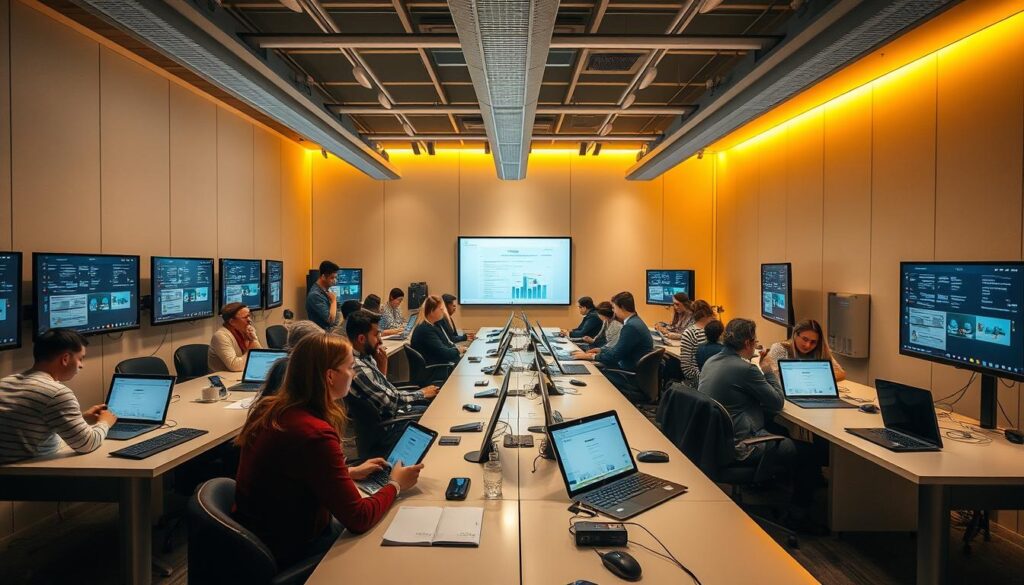“The best way to predict the future is to create it.” – Peter Drucker
In today’s digital world, user experience is key. Usability Testing Services are vital for forward-thinking companies. By using usability testing, we can make digital experiences that keep customers coming back.
Our Usability Testing Services aim to make apps and websites better. We use data to find and fix problems users face. This makes experiences better for customers and support teams. With 79% of users unlikely to return after a bad experience, our services are essential for success.
We focus on what customers want most, making experiences that turn users into loyal fans. As 70% of users expect more from digital services, our services help meet these expectations. This keeps us ahead and exceeds what customers expect.
Key Takeaways
- Usability Testing Services are essential for creating exceptional digital experiences that captivate and retain customers.
- Our expert solutions identify and solve common user barriers to improve customer satisfaction and support team efficiency.
- By aligning product roadmaps with user-driven data, we prioritize the features that matter most to customers, driving innovation and loyalty.
- Usability testing is crucial for staying ahead of the curve and exceeding the increasing expectations of digital service users.
- Our comprehensive approach to usability testing ensures a better return on investment for your digital products.
What Are Usability Testing Services?
Usability testing services aim to make digital products easier to use. They involve watching users interact to find and fix problems. The goal is to make sure users enjoy using the product.
Since most users leave after a bad experience, it’s key to get it right.
Definition and Purpose
Usability testing checks how well a product works by testing it with real users. It aims to find issues, get feedback, and judge the user experience. This way, the design can be improved to meet user needs better.
Importance in Product Development
Usability testing is vital in making products. It helps avoid bad feedback and low ratings. These can scare off new users.
User Testing, Heuristic Evaluation, and Accessibility Testing are key to a smooth user experience. They lead to happier users and a more effective product.
“Usability testing is essential for observing real users interacting with websites, apps, or products to ensure an effective user experience.”
By using User Testing, Heuristic Evaluation, and Accessibility Testing in product development, companies learn a lot. They see how users interact, find problems, and make the product better.
Benefits of Usability Testing
Usability testing has many benefits that can make your products or services better. It helps find and fix problems early, making your solutions meet user needs. This leads to happier customers and more people using your products.
Improved User Satisfaction
When users find it easy to use your product or website, they’re happier. Usability testing shows us how users behave and what they need. This lets us design things that fit their needs, making them more loyal and satisfied.
Increased Product Effectiveness
Usability testing is key in Persona Development, Journey Mapping, and Iterative Design. It shows how users interact with your product, helping us make it better. This makes your product easier to use, leading to more sales and success.
Cost-Effective Design Iterations
Fixing usability issues early saves a lot of money. Usability testing finds problems early, saving time and money. This lets us keep improving based on what users say, making our products better.
“Usability testing is essential for creating products that users love. By understanding their needs and pain points, we can design solutions that truly resonate with them.”
Using usability testing is a smart move for businesses. It helps create great user experiences, keeps customers coming back, and keeps you ahead. By using this tool, you can make your products and services even better, leading to more success.
Types of Usability Testing Methods
CtrlS.tech offers many usability testing services to improve your digital solutions. We use methods like remote testing, in-person evaluations, and A/B testing. Our User Experience Research experts aim to deeply understand how users behave and what they like.
Remote Usability Testing
Remote usability testing lets participants and facilitators talk and observe in real-time. It’s flexible and cost-effective. This way, we can get feedback from users all over the world.
In-Person Usability Testing
Our team also does in-person testing. This method lets us see how users act and react. It gives us deeper insights that help improve designs.
A/B Testing
A/B testing shows us what users prefer by comparing different options. It helps us find ways to make our digital solutions better. This way, we ensure users have the best experience.
At ctrls.tech, we use many testing methods to improve your digital experiences. Contact us to learn more about our User Experience Research and Usability Evaluation services.
| Usability Testing Method | Key Characteristics | Advantages | Disadvantages |
|---|---|---|---|
| Remote Usability Testing | Participants and facilitators engage in real-time sessions remotely | Cost-effective, flexible, and able to reach a diverse user base | May lack the depth of in-person observation and interaction |
| In-Person Usability Testing | Direct observation of user behavior in a controlled environment | Provides deeper insights into user interactions and reactions | Can be more resource-intensive to organize and conduct |
| A/B Testing | Presents users with two or more distinct options to compare preferences | Identifies opportunities for differentiation and optimization | Requires a larger user sample to generate statistically significant results |

“Usability testing is not just about finding problems; it’s about understanding how people think, feel, and behave when they interact with your product or service.”
Key Metrics for Usability Testing Analysis
When doing User Testing, Heuristic Evaluation, and Accessibility Testing, it’s key to look at certain metrics. These metrics help us understand how users feel about a product. The main ones are task success rate, time on task, and user satisfaction score.
Task Success Rate
The task success rate shows how many users can finish a task. A study by Jeff Sauro found it’s about 78% on average. A higher rate means the design is easy to use. A lower rate means it needs work.
Time on Task
The time on task metric shows how long it takes to do a task. Looking at this can help find problems and make things better. Faster times mean the product works well.
User Satisfaction Score
The user satisfaction score, often from the System Usability Scale (SUS), measures how users feel about a product. It usually scores around 68. A higher score means the product is more user-friendly. It’s important to keep an eye on this to make sure the product meets user needs.
By watching these key metrics, companies can make better choices to improve their products. It’s important to keep checking these metrics to stay ahead and meet user needs better over time.
| Usability Metric | Description | Benchmark |
|---|---|---|
| Task Success Rate | Percentage of users who can complete a task successfully | 78% on average |
| Time on Task | Duration it takes users to complete a specific task | Faster task completion times correlate with higher product effectiveness |
| User Satisfaction Score | Quantitative assessment of user’s perceived usability, typically measured by the System Usability Scale (SUS) | Average SUS score of 68 |
“Continuous monitoring of usability metrics helps track improvements over time and ensures that products meet user needs effectively.”
How to Choose the Right Usability Testing Service
Choosing the right usability testing service is key. Look at the company’s expertise and their testing methods. Find providers with skilled researchers for full usability studies. They should have a wide range of participants to match your users.
Make sure they give detailed reports with key findings and user feedback. Also, check if they offer flexible plans for ongoing testing.
Evaluating Company Expertise
The success of your testing depends on the provider’s expertise. Look for companies with experience in Persona Development and Journey Mapping. These skills help understand user needs.
Choose providers with a track record in usability studies for similar products. They will have the knowledge to give you valuable results.
Understanding Testing Methodologies
Learn about the testing methods the service uses. Some focus on remote testing, others on in-person sessions. Check how they interact with participants and collect data.
Good providers like ctrls.tech offer various methods to meet your needs.
| Usability Testing Service | Pricing | Unique Features | Ideal Users |
|---|---|---|---|
| UserTesting | $1500 to $2500 per seat | Diverse participant pool, comprehensive reporting, video recordings | Enterprises, agencies, and product teams with larger budgets |
| Optimal Workshop | Starting at $129 per user/month | Wide range of usability testing tools, affordable plans | Small to medium-sized businesses and teams |
| Lyssna (formerly UsabilityHub) | Free tests up to 2 minutes, paid plans starting at $75/month | Pay-per-answer remote research model, quick user feedback | Startups, small businesses, and teams with limited budgets |
“Usability testing is an essential part of the product development process, helping us create experiences that truly resonate with our users.”
By carefully evaluating the expertise and testing methodologies of usability service providers, you can ensure that your user research efforts yield valuable insights and drive meaningful improvements to your products or services.
The Usability Testing Process Explained
Creating great user experiences needs a careful, step-by-step approach. At the core of this is usability testing, a key step that shows how real users use a product or service. By watching and listening to users, we find problems, make things better, and create experiences that really connect with people.
Planning and Preparation
The first step is planning and getting ready. We set clear goals, make test scenarios that match real use, and pick a variety of participants. Experts say using 3-5 users per test can find up to 85% of major design issues.
Conducting the Test
During the test, we watch as users try out the product. We track things like how fast they finish tasks, how well they do, and when they get confused. We keep tasks to 5 or less per user to get the most important info in 60 minutes.
Analyzing Results and Reporting
The last step is digging into the data to find important insights. By looking at how users act, we find what needs to get better and make plans for the next design steps. This leads to a detailed report that guides how to improve the user experience.
Throughout the testing, we focus on making things better for the user. We make sure our products are not just pretty but also easy to use, efficient, and valuable to our customers.
| Usability Testing Best Practices | Key Metrics |
|---|---|
|
|
Real-World Applications of Usability Testing
Usability testing is key in today’s digital world. Companies in many fields use it to make products better. It helps improve websites, e-commerce sites, mobile apps, and software.
Websites and E-commerce Platforms
Usability testing makes websites and e-commerce sites better. It helps with navigation and boosts sales. Strava, for instance, sped up their updates by 6 times. This made their fitness app easy to use.
Mobile Applications
For mobile apps, usability testing is crucial. It makes sure apps work well on all devices. HitRecord, a creative platform, launched their paid version in just six months. They did this by testing their app with users.
Software Interfaces
Usability testing is also vital for software. It makes workflows smoother and learning easier. Shopify’s Experts platform is a great example. They used testing to make their platform more valuable for merchants.



